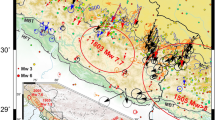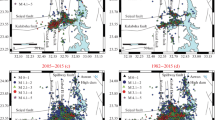Abstract
The world’s most geologically complex Himalayan arc is well known for its tectonic and seismic activities due to the collision of Indian and Eurasian plates. Based on these elements [global positioning system (GPS) deformation measurements, scaling exponent (D) of the tectonic elements and past seismicity] studied here can contribute to better understanding of dynamics and complexities of earthquakes occurrence in any region. In the present paper, the crustal deformation is analyzed with the 3-year campaign and continuous GPS sites data. The velocity vectors of the sites with IGS05 reference frame ranges from 35 to 50 mm/year and give strain-rate measurements up to 130 × 10−9 strain/year. Further, the study region was divided into number of blocks of 1° × 1° that gives different D value based on the presence and distribution of tectonic elements in a particular block. One of the blocks was identified with very high D value of 1.82, where the least seismic activity and extensive convergence due to strain accumulation in comparison with other blocks of higher capacity dimensional value has been observed. Particularly this block lying between latitude 29°N–30°N and longitude 79°E–80°E is considered to be the probable highest seismic hazard zone in the study area. Significance of the combined application of GPS study, scaling exponent and the characteristics of seismicity are stated as helpful methods in the identification of hazardous zone in the Eastern part of the central seismic gap in the Himalaya or in any active areas of the world.











Similar content being viewed by others
References
Akilan A, Balaji S, Malaimani EC, Ravikumar N, Abilash K (2012) Current scenario of crustal deformation and strain distribution around the equatorial Indian Ocean region using GPS-geodesy. J Ind Geophys Union 16(1):21–28
Altamimi Z, Collilieux X, Legrand J, Garayt B, Boucher C (2007) ITRF2005: a new release of the international terrestrial reference frame based on time series of station positions and Earth orientation parameters. J Geophys Res 112:B09401. doi:10.1029/2007JB004949
Ambraseys N, Douglas J (2004) Magnitude calibration of north Indian earthquakes. Geophys J Int 159:165–206
Ambraseys N, Jackson D (2003) A note on early earthquakes in northern India and southern Tibet. Curr Sci 84:571–582
Banerjee P, Burgmann R (2002) Convergence across the northwest Himalaya from GPS measurements. Geophys Res Lett 29(13):301–304
Banerjee P, Burgmann R, Nagarajan B, Apel E (2008) Intraplate deformation of the Indian subcontinent. Geophys Res Lett 35:L18301. doi:10.1029/2008GL035468
Barazangi M, Ni J (1982) Velocities and propagation characteristics of Pn and Sn beneath the Himalayan arc and Tibetan plateau: possible evidence for underthrusting of Indian continental lithosphere beneath Tibet. Geology 10:179–185
Bilham R, Bodin P, Jackson M (1995) Entertaining a great earthquake in western Nepal: historic inactivity and development strain. J Nepal Geol Soc 11:73–88
Bilham R, Larson K, Freymueller J, IDYLHIM members (1997) GPS measurements of present-day convergence across the Nepal Himalaya. Nature 386:1–94
Cannizzaro L (2008) Analysis of temporal correlations in GPS time series: comparison between different methods at different space scale. PhD Thesis in Geodesy and Geomatics, Polytechnic of Milan
Célérier J, Harrison TM, Yin A, Webb AAG (2009) The Kumaun and Garwhal Lesser Himalaya, India. Part 1: structure and stratigraphy. Geol Soc Am Bull 121((9-10)):1262–1280
Chauveau J, Rousseau D, Chapeau-Blondeau F (2010) Fractal capacity dimension of three-dimensional histogram from color images. Multidimens Syst Signal Process 1:197–211
Copley A (2008) Kinematics and dynamics of the southeastern margin of the Tibetan Plateau. Geophys J Int 174:1081–1100
Dach R, Hugentobler U, Fridez P, Meindl M (2007) Bernese GPS Software Version 5.0. Astronomical Institute, University of Bern, Switzerland
Dasgupta S, Pande P, Ganguly D, Iqbal Z, Sanyal K, Venkatraman NV et al (2000) Seismotectonic atlas of india and its environs, Geological Survey India, Calcutta
Dumka RK, Kotlia BS, Kumar K, Satyal GS, Joshi LM (2014) Crustal deformation revealed by GPS in Kumaun Himalaya, India. J Mount Sci 11(1):41–50
Feder J (1988) Fractals. Plenum, New York
Gahalaut VK, Nagarajan B, Catherine JK, Kumar S (2006) Constraints on 2004 Sumatra–Andaman earthquake rupture from GPS measurements in Andaman–Nicobar Islands. Earth Planet Sci Lett 242:61–68
Gahalaut VK, Kundu B, Laishram SS, Catherine J, Kumar A, Singh MD, Tiwari RP, Chadha RK, Samanta SK, Ambikapathy A, Mahesh P, Bansal A, Narsaiah M (2013) Aseismic plate boundary in the Indo-Burmese wedge, northwest Sunda Arc. Geology 41(2):235–238
Gonzato G, Mulargia F, Marzocchi W (1998) Practical application of fractal analysis: problems and solutions. Geophys J Int 132:275–282
Hirata T (1989) Fractal dimension of fault systems in Japan: fractal structure in rock fracture geometry at various scales. Pure appl Geophys 131:157–170
Hodges KV (2000) Tectonics of the Himalaya and south Tibet from two perspectives. Geol Soc Am Bull 112:324–350
Jade S (2004) Estimates of plate velocity and crustal deformation in the Indian subcontinent using GPS geodesy. Curr Sci 86:1443–1448
Jade S, Malay Mukul, Kumar Bhattacharya Anjan, Vijayan MSM, Saigeetha Jaganathan, Ashok Kumar, Tiwari RP, Arun Kumar, Kalita S, Sahu SC, Krishna AP, Gupta SS, Murthy MVRL, Gaur VK (2007) Estimates of interseismic deformation in northeast India from GPS measurements. Earth Planet Sci Lett 263:221–234. doi:10.1016/j.epsl.2007.1008.1031
Jade S, Rao HR, Vijayan MSM, Gaur VK, Bhatt BC, Kumar K, Jaganathan S, Ananda MB, Kumar PD (2011) GPS-derived deformation rates in northwestern Himalaya and Ladakh. Int J Earth Sci (Geol Rundsch) 100:1293–1301
Jouanne F, Mugnier JL, Pandey MR, Gamond JF, Le Fort P, Serrurier L, Vigney C, Avouac JP (1999) Oblique convergence in the Himalayas of western Nepal deduced from preliminary results of GPS measurements. Geophys Res Lett 26(13):1933–1936
Jouanne F, Mugnier JL, Gamond JF, Le Fort P, Pandey MR, Bollinger L, Flouzat M, Avouac JP (2004) Current shortening across the Himalayas of Nepal. Geophy J Int 57:1–14. doi:10.111/j.1365-246X.2004.02180.x
Kaniuth K, Vetter S (2005) Vertical velocities of European coastal sites derived from continuous GPS observations. GPS Solut 9:32–40
Khattri KN (1987) Great earthquakes, seismicity gaps and potential for earthquake disaster along Himalaya plate boundary. In: Mogi K, Khattri KN (ed). Earthquake prediction. Tectonophysics 138:79–92
Korvin G (1992) Fractal models in the earth sciences. Elsevier, Amsterdam
Kothyari GC, Pant PD (2008) Evidences of active deformation in the northwestern part of Almora in Kumaun Lesser Himalaya: a geomorphic perspective. J Geol Soc India 72:353–364
Kumar S, Wesnosusky WG, Rockwell TK, Ragona D, Thakur VC, Seitz GG (2001) Earthquake recurrence and rupture dynamics of Himalayan Frontal Thrust, India. Science 294:2328–2331
Kumar S, Wenousky SG, Rockwell TK, Briggs RW, Thakur VC, Jayangondaperumal R (2006) Paleoseismic evidence of great surface rupture earthquakes along the Indian Himalaya. J Geophys Res 111:B03304
Leick A (2004) GPS satellite surveying, 3rd edn. Wiley, Hoboken
Mandelbrot BB (1985) Self-affine fractals and fractal dimension. Phys Scr 32:257–260
Ni J, Barazangi M (1984) Seismotectonics of the Himalayan collision zone: geometry of the underthrusting Indian plate beneath the Himalaya. J Geophys Res 89(B2):1147–1163
Ogata Y (1999) Seismicity analysis through point-process modeling: a review. Pure App Geophys 155:471–507
Paul A, Sharma ML (2011) Recent earthquake swarms in Garhwal Himalaya: a precursor to moderate to great earthquakes in the region. J Asian Earth Sci 42:1179–1186
Paul J, Burgmann R, Gaur VK, Bilham R, Larson KM, Ananda MB, Jade S, Mukul M, Anupama TS, Satyal G, Kumar D (2001) The motion and active deformation of India. Geophys Res Lett 28(4):647–650
Peltzer G, Saucier F (1996) Present day kinematics of Asia derived from geological fault rates. J Geophys Res 101:27943–27956
Ponraj M, Miura S, Reddy CD, Prajapati SK, Amirtharaj S, Mahajan SH (2010) Estimation of strain distribution using GPS measurements in the Kumaun region of Lesser Himalaya. J Asian Earth Sci 39:658–667. doi:10.1016/j.jseaes.2010.04.019
Ponraj M, Miura S, Reddy CD, Amrithraj S, Mahajan SH (2011) Slip distribution beneath the Central and Western Himalaya inferred from GPS measurements. Geophys J Int 85:724–736
Powell CM, Conaghan PJ (1973) Plate tectonics and the Himalayas. Earth Planet Sci Lett 20:1–12
Powers PM, Lillie RJ, Yeats RS (1998) Structure and shortening of the Kangra and Dehra Dun reentrants, Sub-Himalaya, India. Geol Soc Am Bull 110:1010–1027
Ram A, Roy PNS (2005) Fractal dimensions of blocks using a box-counting technique for the 2001 Bhuj Earthquake, Gujarat, India. Pure App Geophys 162:531–548
Rikitake T (1982) Earthquake Forecasting and Warning. D. Reidel Publishing Co, Dordrecht
Sagiya T, Miyazaki S, Tada T (2000) Continuous GPS array and present-day crustal deformation of Japan. Pure appl Geophys 157:2303–2322
Searle MP (1991) Geology and tectonics of the Karakoram Mountains. Wiley, New York
Sunmonu LA, Dimri VP (2000) Fractal geometry and seismicity of Koyna–Warna, India. Pure appl Geophys 157:1393–1405
Thingbaijam KKS, Nath SK, Yadav A, Raj A, Walling MY, Mohanty WK (2008) Recent seismicity in Northeast India and its adjoining region. J Seismol 12:107–123
Turcotte DL (1989) Fractals in geology and geophysics. Pure appl Geophys 131:171–196
Turcotte DL (1997) Fractals and chaos in geology and geophysics, 2nd edn. Cambridge University Press, New York
Utsu T (1984) Estimation of parameters for recurrence models of earthquakes. Bull Earthq Res Inst Univ Tokyo 59:53–66
Valdiya KS (2001) Reactivation of terrain defining boundary thrust in central sector of the Himalaya: implication. Curr Sci 81(11):1418–1431
Valdiya KS, Joshi DD, Sanwal R, Tandon SK (1984) Geomorphological development across the active main boundary thrust: an example from the Nainital Hills in Kumaun Himalaya. J Geol Soc India 25:761–774
Valdiya KS, Rana RS, Sharma PK, Dey P (1992) Active Himalayan frontal fault, main boundary thrust and Ramgarh Thrust in southern Kumaun. J Geol Soc India 40:509–528
Verma M, Bansal BK (2012) Indian National GNSS Programme: crustal deformation measurements in the Indian Sub-continent. J Asian Earth Sci 50:1–6
Wesnousky SG, Kumar S (1999) Uplift and convergence along the Himalayan frontal thrust of India. Tectonic 18(6):967–976
Wessel P, Smith WHF (1998) New, improved version of the Generic mapping tools released. EOS Trans AGU 79:579
Wu JC, Tang HW, Chen YQ, Li YX (2006) The current strain distribution in the North China Basin of eastern China by least squares collocation. J Geodyn 41:462–470
Acknowledgments
We gratefully acknowledge Ministry of Earth Science, Government of India for sponsoring the work by The Project (MoES/P.O. (Seismo)/GPS/60/2006).The Survey of India is acknowledged for the continuous sites data. We also acknowledge all the persons who helped in GPS data acquisition in Himalayan region. The Abdus Salam ICTP, Trieste, Italy, is acknowledged for Junior Associate support to PNSR. The authors acknowledge Paul Wessel and University of Hawaii for General Mapping Tools (Wessel and Smith 1998). The first author wishes to thank the Director, CSIR-National Geophysical Research Institute, Hyderabad for all the support for research work.
Author information
Authors and Affiliations
Corresponding author
Electronic supplementary material
Below is the link to the electronic supplementary material.
Rights and permissions
About this article
Cite this article
Mondal, S.K., Borghi, A., Roy, P.N.S. et al. GPS, scaling exponent and past seismicity for seismic hazard assessment in Garhwal–Kumaun, Himalayan region. Nat Hazards 80, 1349–1367 (2016). https://doi.org/10.1007/s11069-015-2026-x
Received:
Accepted:
Published:
Issue Date:
DOI: https://doi.org/10.1007/s11069-015-2026-x




